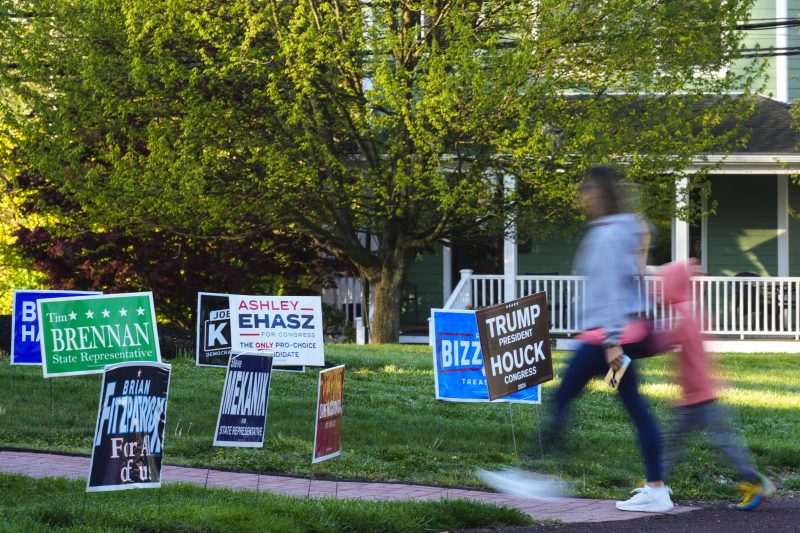(NEXSTAR) — With Election Day less than two months away, the country is once again deep in political races, including the tight battle for the White House. A drive around your neighborhood may expose you to plenty of signs — literally — of who is running for which seat.
Those signs, usually placards measuring about 22” by 18” and sporting a candidate’s name, aren’t a new campaign method. The first U.S. presidential campaign merchandise dates back to the 1828 race between John Quincy Adams and Andrew Jackson, with political posters and signs becoming more popular in the following years.
By the early 1900s, ad agencies were stepping in to help better establish the yard signs. The signs we see today, according to experts, are largely the same as those early placards.
But have you ever wondered if the signs even matter? Think about it: Have you ever been influenced by a yard sign you saw?
According to experts, a sign’s effectiveness may depend on the race it relates to, and who is putting it out.
Ben Griffin and name recognition
Studies have shown that when it comes to down-ballot races — usually non-presidential, like school board or a county-level representative — it’s important for the candidate to build name recognition. Yard signs can do that, even if the candidate is not real, one study found.
In that study, researchers placed signs for a fictitious candidate in a Nashville yard, near an elementary school, months before the actual election. Three days later, parents were surveyed and asked to rank their top three choices for the open seats. Of the parents believed to have seen the fictitious signs, nearly a quarter selected the fake candidate.
That may not always be the case, though. It’s possible the community may already be familiar with someone running for a local office, and the signs can help “reinforce” that they are “the right candidate,” Dr. Patricia Crouse, a Professor of Public Administration and Political Science at the University of New Haven, told Nexstar.
What about presidential candidates?
Most of these candidates “already have near universal name recognition,” Dr. Todd Makse, a professor of politics and international relations at Florida International University told Nexstar.
Putting out a yard sign at all may have a bigger impact on you than the election. Having a sign (or signs) is like flying a flag for your favorite sports team. Everyone knows who you root for, and you may encourage other like-minded fans to put out their own flag. You may also spark a neighbor to fly the rival team’s flag.
Regardless, it’s all about expression, which Makse, a co-author of “Politics on Display: Yard Signs and the Politicization of Social Spaces,” called “the most important motive for displaying a sign.” Crouse explained that yard signs may allow someone who doesn’t “get deeply involved in any sort of campaigning” to not only express their opinion but feel involved in the election.
But what about the yard near you with multiple campaign signs?
According to Makse and his co-authors, there are two main factors that can predict the displaying of multiple signs: “difference in affect toward the candidates (i.e., how much you like your candidates versus how much you dislike the other candidate) and whether you live on a busy street.”
“In some cases (e.g., when people start posting five or more signs for the same candidate), I think this is just the nonverbal equivalent of shouting,” he explained.
Yard signs can even serve another purpose, known as “permission structures.”
“[It’s] the idea that in communities dominated by one party, a small number of signs supporting the other candidate — especially in races where the locally dominant party’s candidate is deeply flawed in some way — can signal to ambivalent voters that it’s OK this one time to vote against their party,” Makse said. “In an era of such deep polarization, this could actually influence voting in presidential races for a specific subset of people.”
Will signs ever go away?
Campaign yard signs may not necessarily sway an election — research has shown the placards could make a difference of between 1 and 2 percentage points — but they likely won’t disappear anytime soon.
Experts previously told NPR that signs can help motivate campaign staff and volunteers while bringing attention to a candidate and making them seem more legitimate, especially in smaller races.
The biggest threat to such signs may instead be more local.
Makse said there have been concerns from sign-displayers that they’ll become a target “of verbal abuse or vandalism from extreme supporters of the other party.”
Crouse shared similar sentiments, saying, “I would not want to see people discouraged from putting signs out.” Still, Makse explained that among the people interviewed for his book, most indicated they want to “avoid hostilities with their neighbors over political signs.”
